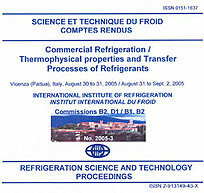
Document IIF
Outil de simulation et de conception pour les condenseurs à serpentin.
A simulation and design tool for wire-and-tube condensers.
Auteurs : SCHWENTKER R. A., AUTE V. C., RADERMACHER R.
Résumé
This paper introduces a simulation tool that can be used to design, model and optimize wire-and-tube condensers used in refrigeration appliances. The model is capable of accounting for natural convection and forced convection heat transfer on the air side. A segment-by-segment modelling approach within each tube is implemented to account for heterogeneous refrigerant flow patterns through the tubes and to account for two dimensional non-uniformity of air distribution across forced convection wire-and-tube condensers. The segment-by-segment approach also allows for the modelling of variable fin densities along the tubes. A subdivided segment model is developed in order to address the significant change of refrigerant properties that can take place between the single and two-phase flow regimes within a segment. A variety of working fluids can be modelled, and a variety of built-in correlations for heat transfer coefficient and friction factor are available. Object-oriented programming techniques are employed to create a highly flexible and customizable design platform, as well as a user-friendly graphic interface. The predictions of the model are verified using experimentally determined data for R134a.
Documents disponibles
Format PDF
Pages : 2005-3
Disponible
Prix public
20 €
Prix membre*
Gratuit
* meilleur tarif applicable selon le type d'adhésion (voir le détail des avantages des adhésions individuelles et collectives)
Détails
- Titre original : A simulation and design tool for wire-and-tube condensers.
- Identifiant de la fiche : 2006-0720
- Langues : Anglais
- Source : Commercial Refrigeration. Thermophysical Properties and Transfer Processes of Refrigerants. Proceedings of the IIR International Conferences.
- Date d'édition : 30/08/2005
Liens
Voir d'autres communications du même compte rendu (140)
Voir le compte rendu de la conférence
-
INTENSIFICATION DE L'ECHANGE DE CHALEUR PAR CON...
- Auteurs : VISTJAK V. B.
- Date : 1986
- Langues : Russe
- Source : Kholodilnaya Tekhnika - n. 10
Voir la fiche
-
A heat transfer correlation for natural draft w...
- Auteurs : MELO C., HERMES C. J. L.
- Date : 05/2009
- Langues : Anglais
- Source : International Journal of Refrigeration - Revue Internationale du Froid - vol. 32 - n. 3
- Formats : PDF
Voir la fiche
-
Heat transfer from a horizontal fin array by na...
- Auteurs : DHARMA RAO V., NAIDU S. V., GOVINDA RAO B., et al.
- Date : 09/2006
- Langues : Anglais
- Source : International Journal of Heat and Mass Transfer - vol. 49 - n. 19-20
Voir la fiche
-
Conjugate analysis of a flat-plate type evapora...
- Auteurs : CAO Y., FAGHRI A.
- Date : 02/1994
- Langues : Anglais
- Source : International Journal of Heat and Mass Transfer - vol. 37 - n. 3
Voir la fiche
-
An experimental investigation of natural convec...
- Auteurs : IZADPANAH E., ZAREI A., AKHAVAN S., et al.
- Date : 09/2018
- Langues : Anglais
- Source : International Journal of Refrigeration - Revue Internationale du Froid - vol. 93
- Formats : PDF
Voir la fiche
